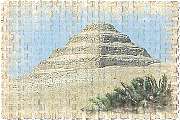|
Saqqara
was one of the main burial fields of the ancient city of Memphis,
capital of Ancient Egypt during the Old Kingdom. It is located
some 40 kilometres from Egypt’s modern day capital, Cairo.
On a clear day, its most prominent monument, the Step Pyramid
of Djoser,
can be seen from Giza, which lies some 17 kilometres to the
North, and from Dashur, which lies 10 kilometres to the South.
Saqqara covers an area of 6Km by 1.5Km. This area is divided
into two main regions:
|
 |

View of the Djoser Step-Pyramid |
Saqqara
North,
which stretches from the Northern Plateau to the unfinished
pyramid of Sekhemkhet, and Saqqara South, stretching
from the pyramid of Sekhemkhet to the funerary monument of Shepseskaf. |
 |
The
modern-day village of Saqqara, which has lent its name to
the entire area, is located due East of Saqqara South.
The
origin of its name is somewhat debatable. Some Egyptologists
believe it is derived from the name of the god Sokar, who,
as a funerary god, must have been connected to the Memphite
burials. Others would rather connect the name ‘Saqqara’ to
a tribe that supposedly roamed the area.
(Jacques Kinnaer)
|